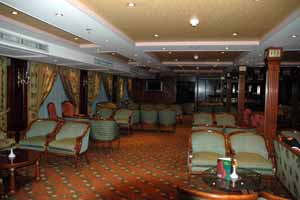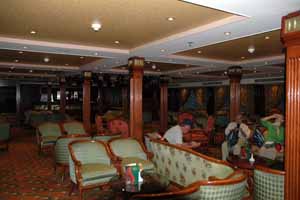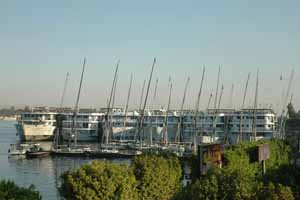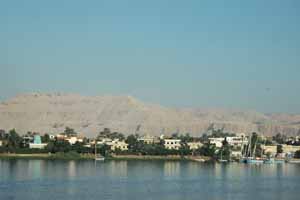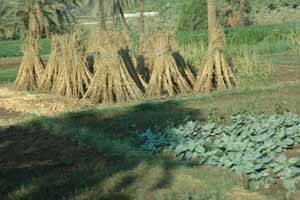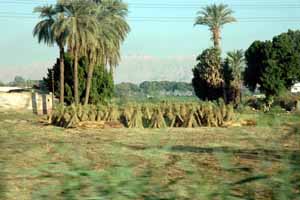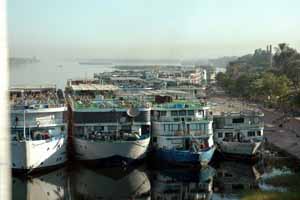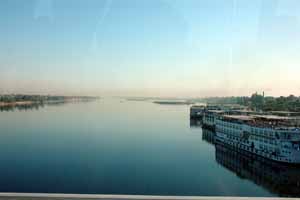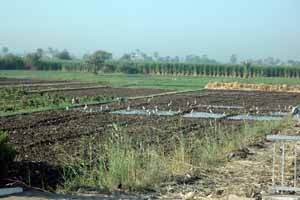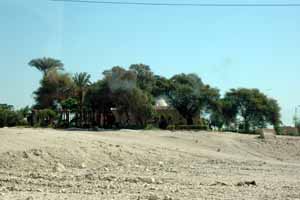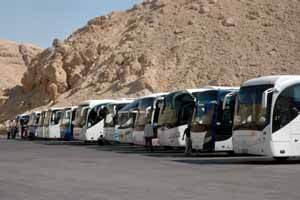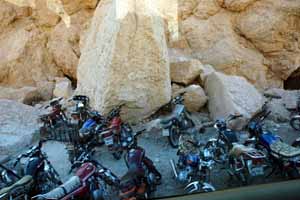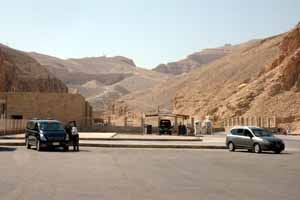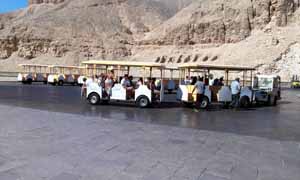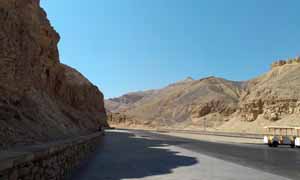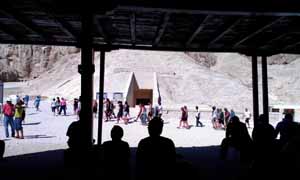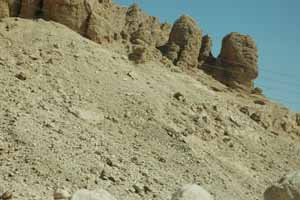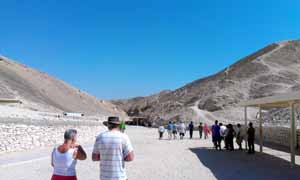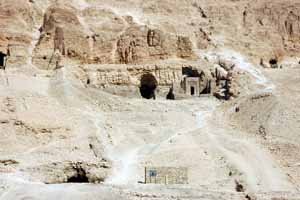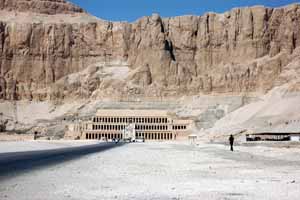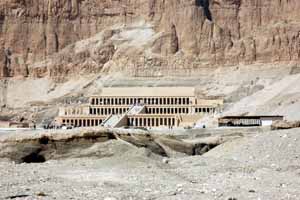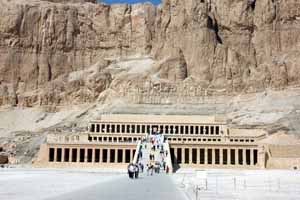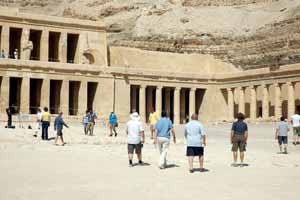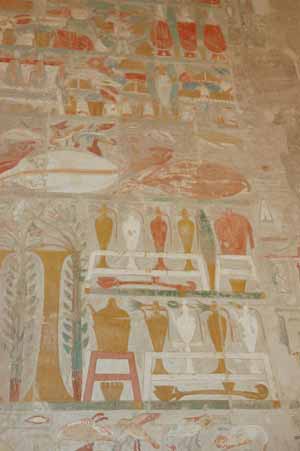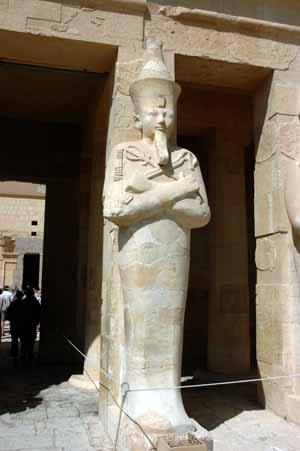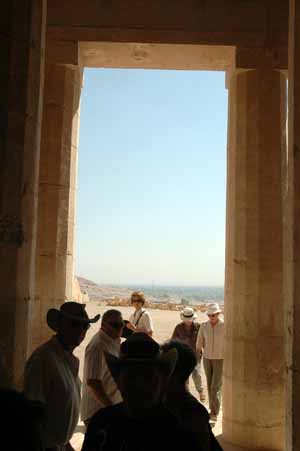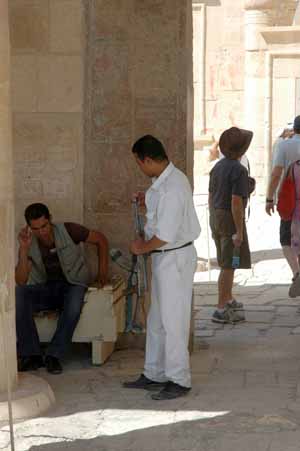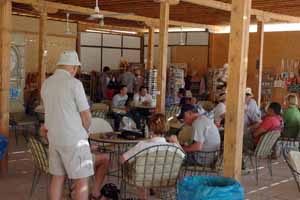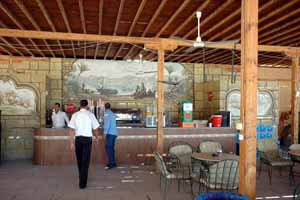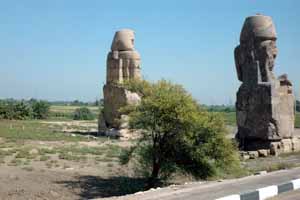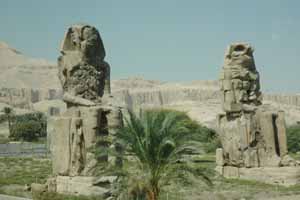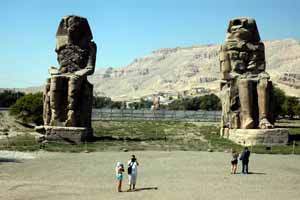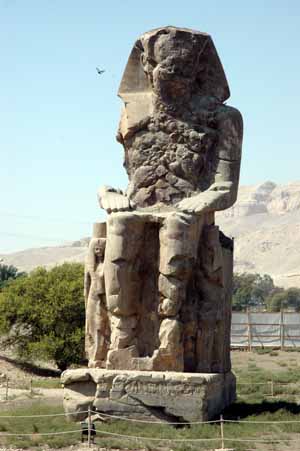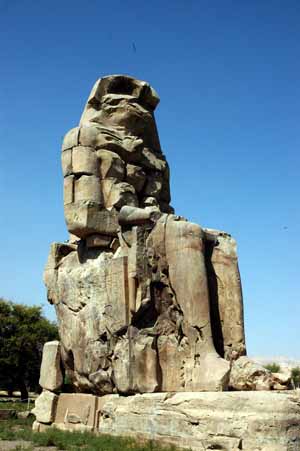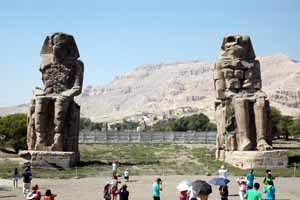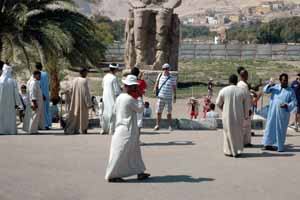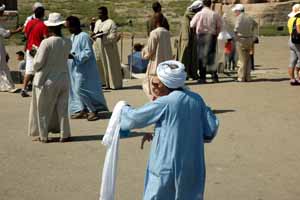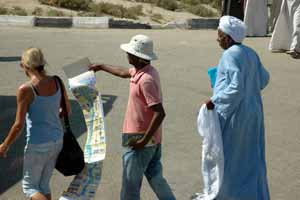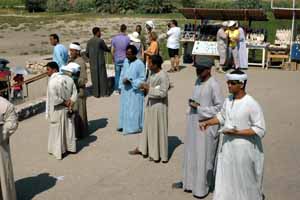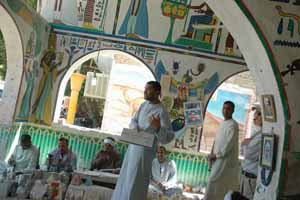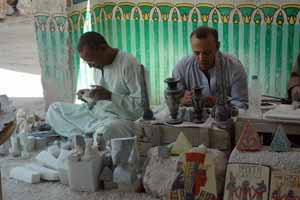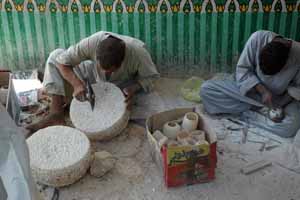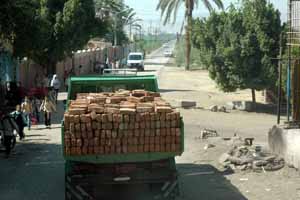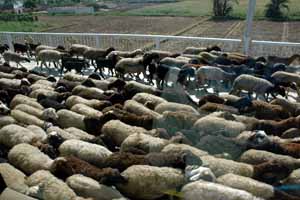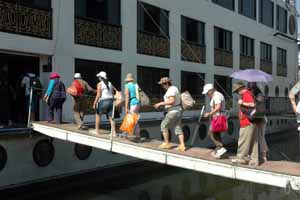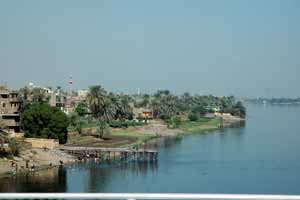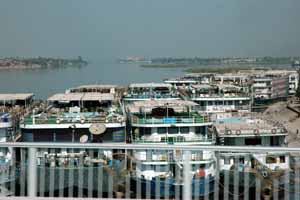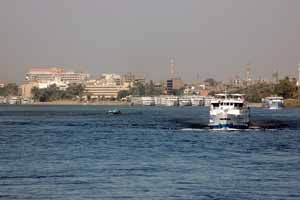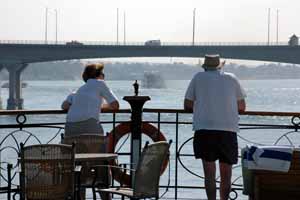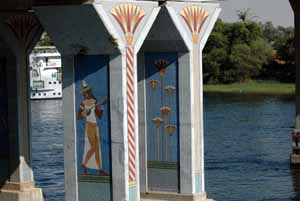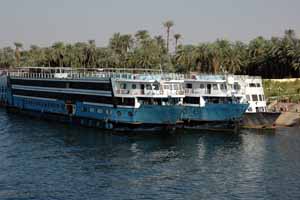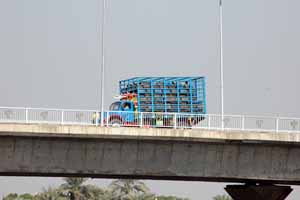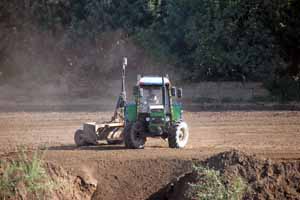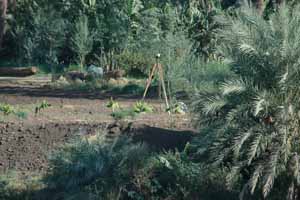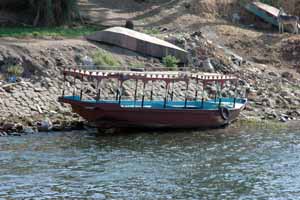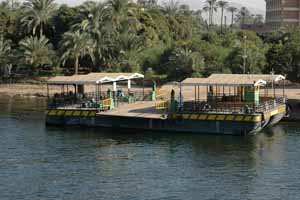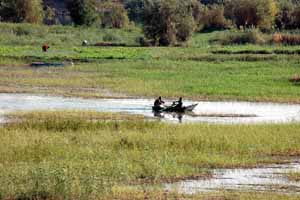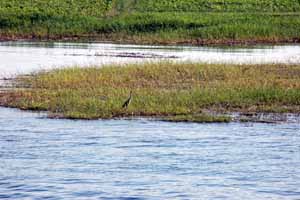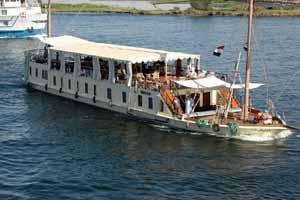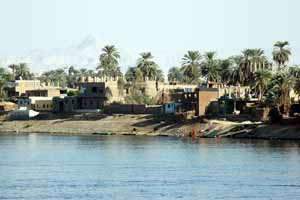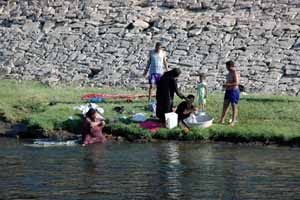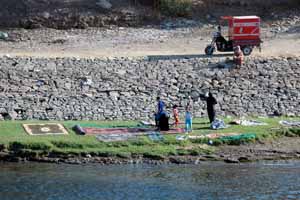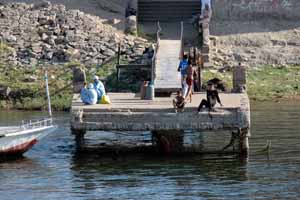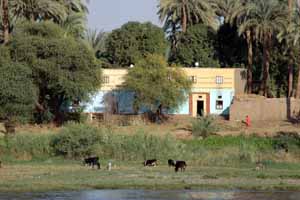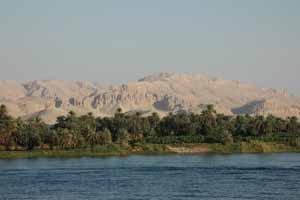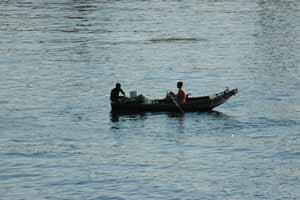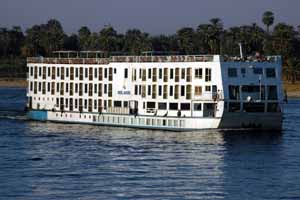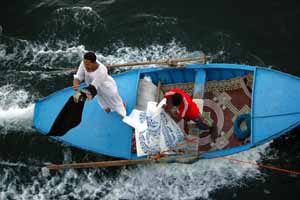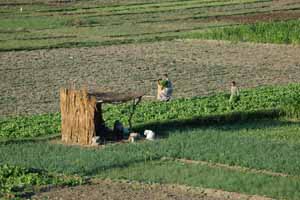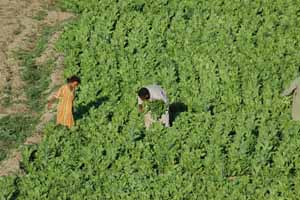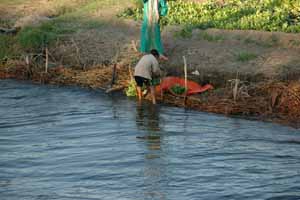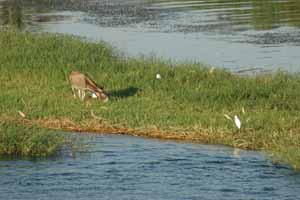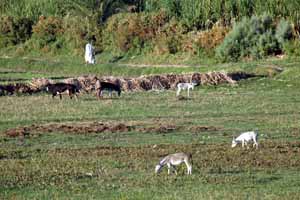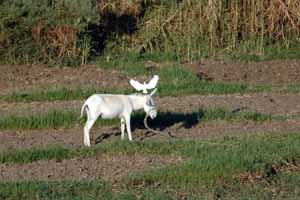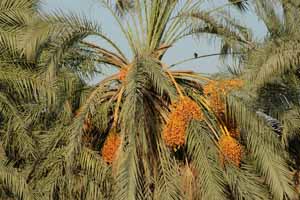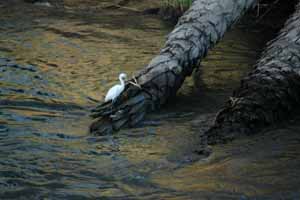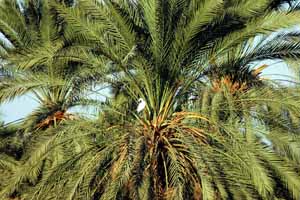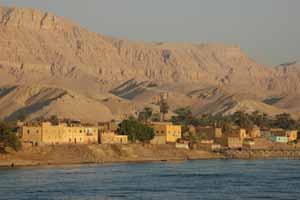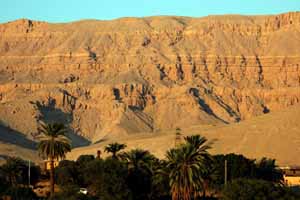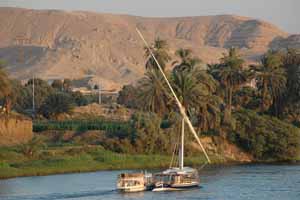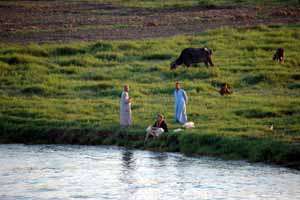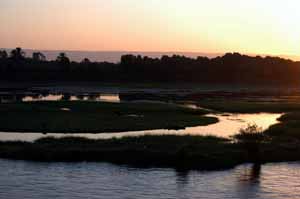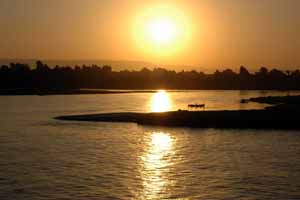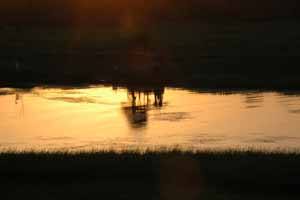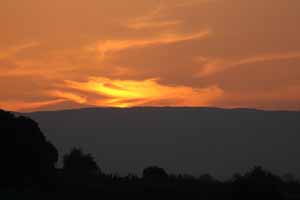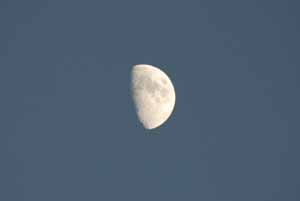Two Weeks in Egypt - October 2012
Day Nine: Valley of the Kings
From our cruise boat, still moored at Luxor, we travelled by bus over the Nile to the far bank to visit the Valley of the Kings and the Temple of Hatshepsut.
We started early but the sun soon rose and the day became unbearably hot. But the sights were amazing - the scale of the construction, their detail and their antiguity.
Valley of the Kings
The story tells that after the early kings of Egypt had built the huge Pyramids in Cairo. later kings realised that the pyramids were susceptible to being broken open and stripped
of the fabulous wealth they contained. So they moved inland to Luxor and hid their tombs underground. The scale of the work, and the skill of the stonemasons was still beyond our abilities today.
We did not have time to visit all of the tombs that were open, and some such as Tutankhamen cost an extra fee, but we saw plenty. The only regret was the prohibition on cameras. With the number
of visitors and the damage that camera flashes were causing, all cameras were banned. Apparently it was beyond the ability of many of the visitors to turn their camera flashes off......
|
Leaving the cruise ship we walk through the main lounge...
|
and the bar.
|
|
|
Onto the bus....
|
Away from the boats and the faluccas.....
|
alongside the Nile.
|
|
Past the cabbages.
|
Past the stooks of corn stalks....
|
under the date palms.
|
|
Alongside the Nile with a fishing boat in the early morning light.
|
Past the laid-up cruise ships
|
over the Nile
|
|
and through the fertile river valley with egrets,
|
sugarcane.....
|
and more green crops.
|
|
Heading for the Valley, we passed "Carters" where the early explorer of the Valley resided.
|
Then up the narrow winding valley to the bus park,
|
where they were lined up in a row.
|
|
Behind the buses were all the motorbikes of the local workers.
|
Looking up the Valley of the Kings.
|
But don't worry, you do not have to walk in that heat....
|
|
The small trains take you all the way up.
|
So we waited in the shade for the next train,
|
and eventually arrived at the first of the tombs, but remember, no cameras!
|
|
After visiting the tombs, we sat in the shade of the refreshment area.
|
Then back down the valley, passing the dry limestone walls.
|
And back towards the buses.
|
The Temple of Hatshepshut
Built into the other side of the hill from the Valley of the Kings lies the huge temple complex of Hatshepsut, the only female ruler of Egypt. The temple faces towards the Nile, lying at the
focal point of a large natural amphitheatre.
|
As we drove towards the Temple, there are many tombs in the valley side.
|
Then the temple appears....
|
and gets larger...
|
|
until you are able to see the whole complex from approach path.
|
Up on the main level you can see the size of the temple....
|
and walk among the pillars.
|
|
Behind the pillars are remnants of the original colours of the complex,
|
the wall friezes
|
and the carvings.
|
|
Gigantic statues of Hatshepsut.
|
Looking out from the top level across the Nile valley.
|
The ever-present security.....
|
|
Looking back down the path, with small crowds still arriving.
|
Then it was into the shade of the cafe and a welcome drink
|
and icecream.
|
|
Panorama looking from the cafe towards the Temple
|
|
Panorama the other way looking across the valley of the Nile.
|
The Colossi of Memnon
Facing the river on the way towards the Temple of Hatschepshut are the huge statues of Memmon. They stand 16.6m high. They may have been the objects referred to in the poem "Ozymandias" by Shelly who wrote:
And on the pedestal these words appear:
"My name is Ozymandias, king of kings:
Look on my works, ye Mighty, and despair!"
Nothing beside remains. Round the decay
Of that colossal wreck, boundless and bare
The lone and level sands stretch far away.
|
|
The statues appear in a flat and featureless plain,
|
closer to the river....
|
but highly visible from the bus.
|
|
Up close they are huge, but broken,
|
wrecked by an ancient earthquake in 27BC,
|
but still standing.
|
|
There were not many people visiting, but
|
there were lots of hawkers, trying desparately to sell you something.....
|
"Madam, you need a scarf, genuine Egptian cotton". But the label says "Made in Pakistan". But you still MUST buy one....
|
|
You will need a map. What do you mean "NO!"????
|
So back to the sidestalls,
|
lined up for the next poor busload to harrass.
|
Alabaster carving then back to the boat
Everywhere you go in this country you are hounded to buy all manner of junk souveniers, including alabaster carvings. Alabaster is a form of calcite, so it relatively soft and simpe
to carve. Most of the objects shoved into your face and machine carved, and many are not even made locally, let alone in Egypt. So it was a novelty to be taken to a local workshop where they
actually carved all manner of objects using purely manual hand carving methods. It was a hot dusty place, but the workers seemed very cheerful, especially when we headed upstairs to the
showroom to buy their handiwork (which we did). From the workshop it was back across the Nile, through the streets of Luxor and onto the boat.
|
The alabaster carvers had a neat story to tell,
|
chipping and grinding in time to the storyteller.
|
It was all done by hand and by eye.
|
|
Back along the streets.
|
Past the local sheep.
|
Then back on board the boat.
|
Cruising up the Nile to Edfu
From the alabaster workshop it was back across the Nile, through the streets of Luxor and onto the boat for a well-deserved beer while we watched life on the Nile drift past on our way to Edfu.
Although beer was popular,
there was also the prospect of a drinkable red wine that we had discovered the previous night. But in typical
Egyptian fashion the several bottles of quite tolerable red wine wre all they had on board so when we came to order more this night - "Sorry sir, we do not have any more. You
drank the last bottle last night, and we do not have any more. What do you mean - go out and buy some more - that concept appeared to be incomprehensible......!
So beer it was, all the way to Aswan @#$%^&***!!!
|
The riverbank.
|
More tied-up cruiseboats
|
Then out into the river
|
|
and past the abandoned cruiseboats.
|
There are many small boats on the Nile,
|
as well as minarets.
|
|
From here on south, bridges were very rare,
|
in fact this is the only one I remember.
|
Grafitti, Egyptian tagging - or art?.
|
|
Tied up cruisers
|
abandoned through lack of tourists.
|
A load of gas cylinders goes overhead.
|
|
This sight was rare - most ploughin was by oxen. But wait, what is the mast on the tractor for?.
|
Yes, GPS guidance!!!!.
|
No bridges, no problem, take the passenger ferry....
|
|
or the car ferry.
|
Now some wildlife - fishermen...
|
heron....
|
|
oxen.
|
A cheaper form of cruising....
|
Complete with tugboat when going upstream.
|
|
Lots of small towns...
|
With locals doing the washing
|
|
|
or sitting around beside the river.
|
Farm buildings come with.....
|
ears!.
|
|
The flood plain was always in contrast to the brown hills.
|
Fishing - a pastime
|
and an occupation.
|
|
A rare cruiser going downstream.
|
And a tug pulling a barge loaded with rocks.
|
Then this pair rowed out, dosging the barge and heading straight in front of our cruiseboat.....
|
|
Then with a deft move the painter was thrown around a staunchion and they were surfing along beside us - only to yell out with cotton wares to sell. Even out here you cannot escape.....!.
|
Plenty of small farm holdings growing crops
|
and harvesting them.
|
|
and washing them in the Nile..
|
I never did work out how the donkeys got onto the small islands????
|
Grazing with the oxen was more obvious.
|
|
Donkeys make good perches for herons.
|
Date palm....
|
plus heron....
|
|
= heron sitting on palm!
|
Fertile delta and hills in the late afternoon sun.
|
The village took on a golden glow.
|
|
Even here there are plenty of half-finished buildings.
|
|
The barren hills are getting closer.
|
|
A falucca in the late sun.
|
A small mosque on the hilltop.
|
As the sun goes down the herons gather.
|
|
The farmers wash and rest.
|
|
And the sun sets over the river.
|
Reflections in the late light.
|
As the sun sets....
|
The moon rises.
|
Back to previous day --------- ---------
 Forward to next day Forward to next day
Return to Trip Index
Last updated: 02/07/2017
|

